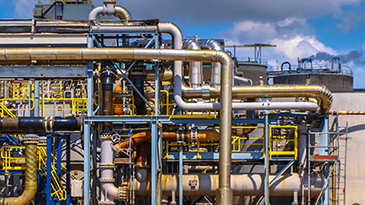If you’re an operator in a crude oil refinery, you’ve probably had to address fouled heat exchanger tubes at one point or another. It’s a common challenge within many process industries.
It is the nature of process streams such as crude oil to foul heat exchanger tubes as they pass through. Fouling reduces heat-transfer capabilities, increasing the plant’s energy consumption. Fouling also increases hydraulic resistance in heat exchanger tubes, reducing throughput. For many oil refineries, throughput reduction is considered the most significant cost of fouling.
Cleaning heat exchangers can take between 3 and 14 days and may cost as much as $50,000 USD per heat exchanger. Also, not all heat exchangers in a plant are equal in terms of the benefit they bring after they are cleaned. For example, some heat exchangers in a crude pre-heat train network in a refinery help transfer much more heat to the passing crude oil than others.
To make matters worse, there are not many ways to directly measure the fouling levels of operating heat exchangers. This makes figuring out the optimal cleaning schedule for a plant’s heat exchangers a challenging task.
Many process operators make their heat exchanger cleaning schedules based on past experiences and simple calculations. This approach does not consider the changes in feed and operating conditions that influence the rate of fouling. As a result, maintenance schedules derived using such techniques are not the most optimal.
However, advancements in process simulation technology make it easier for operators to determine the fouling levels of their heat exchangers and assess the economic benefit of cleaning individual heat exchanger units. Accurate simulation of heat exchanger operations in the context of the broader process is the key. The latest tools allow engineers to incorporate rigorous models of heat exchangers into process simulation flowsheets. In addition to determining fouling levels of heat exchangers, this solution also enables operators to predict operational issues such as erosion and vibration issues.
Many refineries worldwide have already benefitted using this solution: one INEOS refinery saved $4 million USD and a Hindustan Petroleum Corporation Limited refinery in Mumbai, India saved $250,000 USD annually.
Register for this webinar to learn directly from AspenTech experts: explore best practices in monitoring your heat exchanger fouling levels by leveraging the latest advancements in process simulation technology.
It is the nature of process streams such as crude oil to foul heat exchanger tubes as they pass through. Fouling reduces heat-transfer capabilities, increasing the plant’s energy consumption. Fouling also increases hydraulic resistance in heat exchanger tubes, reducing throughput. For many oil refineries, throughput reduction is considered the most significant cost of fouling.
Cleaning heat exchangers can take between 3 and 14 days and may cost as much as $50,000 USD per heat exchanger. Also, not all heat exchangers in a plant are equal in terms of the benefit they bring after they are cleaned. For example, some heat exchangers in a crude pre-heat train network in a refinery help transfer much more heat to the passing crude oil than others.
To make matters worse, there are not many ways to directly measure the fouling levels of operating heat exchangers. This makes figuring out the optimal cleaning schedule for a plant’s heat exchangers a challenging task.
Many process operators make their heat exchanger cleaning schedules based on past experiences and simple calculations. This approach does not consider the changes in feed and operating conditions that influence the rate of fouling. As a result, maintenance schedules derived using such techniques are not the most optimal.
However, advancements in process simulation technology make it easier for operators to determine the fouling levels of their heat exchangers and assess the economic benefit of cleaning individual heat exchanger units. Accurate simulation of heat exchanger operations in the context of the broader process is the key. The latest tools allow engineers to incorporate rigorous models of heat exchangers into process simulation flowsheets. In addition to determining fouling levels of heat exchangers, this solution also enables operators to predict operational issues such as erosion and vibration issues.
Many refineries worldwide have already benefitted using this solution: one INEOS refinery saved $4 million USD and a Hindustan Petroleum Corporation Limited refinery in Mumbai, India saved $250,000 USD annually.
Register for this webinar to learn directly from AspenTech experts: explore best practices in monitoring your heat exchanger fouling levels by leveraging the latest advancements in process simulation technology.




Leave A Comment